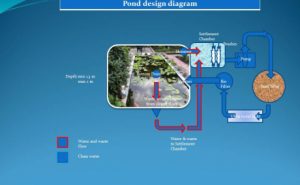Koi 911 offers a fully integrated service to corporate and home pond owners. Koi 911 business objective is to ease the task of the Koi keeper and within doing so ultimately ensure that fish and pond life flourish.

If you not using Koi 911 to build your pond ensure that the perspective builder understands the design diagram and able to draw it and explain it in detail.
Koi pond construction is very specialized. It is far more difficult and complicated than building a swimming pool.
1 Pond
A depth of at least 1m, preferably 1.5 – 2m. Giving the Koi plenty of room to vertically exercise and, will not look overstocked and crowded. Not more than 1 big (40cm) fish per 1000 liters.
A floor sloped to one or more bottom drains. A sloped floor towards the bottom drain allows waste and debris to collect as it naturally gravitates to the bottom drain. This greatly assists in keeping the pond floor clean and prevents waste material that would rot and create anaerobic bacteria.
No pumps, pipes or filters should be placed inside the pond. A chamber to house the filter system, neat and out of sight.
2 Bottom drain
Placed in the lowest point of the pond floor. This allows debris and waste through gravitation into a settlement chamber where the “dirty” water is cleaned through a filter system and eventually clean water is pumped back into the pond.
3 Skimmer
A Skimmer placed on the pond surface pulls in debris and assist in keeping the pond clean and prevent excess debris the opportunity to sink to the bottom to rot and create anaerobic bacteria.
4 Brushes
5 Chamber
This chamber is built near the pond, with the top at the same level and connected to the bottom drain. Waste from the bottom drain gravitates and settles in this chamber, which housed brushes as the first step in filtration trapping large debris and waste. It also prevents leaves to accumulate in the pump basket. This first pre-filtration process prepares the water for secondary filter systems, all a process of ensuring a constant flow of clean water back to the pond to promote a stable biological water system. Settlement chambers should be at least 1m x 1m x 900mm deep.
6 Sand Filters
This is where lighter material, that didn’t settle in the settlement chamber, is filtered for the second time leaving the water crystal clear and free from solids. There is a variety of materials used to accomplish this but no matter which is chosen, it must be cleaned from time to time.
7 Bio Filter
A certain kind of bacteria is healthy for a pond’s nitrification cycle. Biological filters are either open chambers or low pressure sealed chambers filled with media. The types of media generally used are a ceramic by-product called Alfa grog, plastic bio-balls or Japanese filter matting, they all have extra surface area for ”good” bacteria to colonize.
8 Pump
An adequate external (pool type) pump that can turn the pond water over several times per day, it is essential to run Koi pond pumps and filters constantly 24 hours per day to keep biological system supplied with oxygen.
9 UV Light
Ultraviolet light is strategically placed on the final water return line which kills off free-floating algae resulting in clearer water and prevents excessive algae growth.
A general guideline is that every 1000 liters of water require 1 watt of UV light. In other words, a 15000-liter pond would need a 15w UV light.
10 Venturi
Installing a venture in the water return line has an important function in that it breaks the surface which greats extra aeration by absorbing oxygen from the air into the water. A venturi assists in providing oxygen to the pond water.
